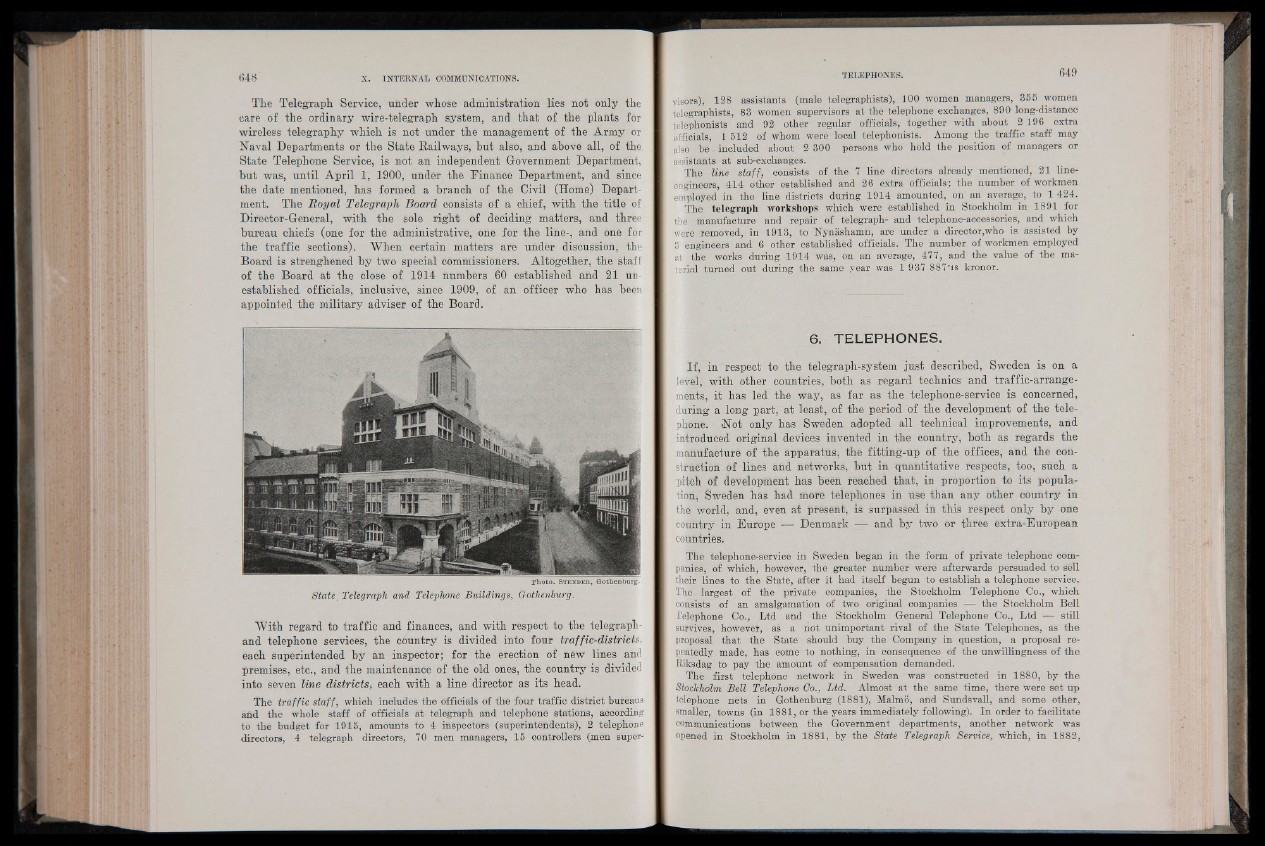
The Telegraph Service, under whose administration lies not only the
care o£ the ordinary wire-telegraph system, and that of the plants for
wireless telegraphy which is not under the management of the Army or
Naval Departments or the State Railways, but also, and above all, of the
State Telephone Service, is not an independent Government Department,
but was, until April 1, 1900, under the Finance Department, and since
the date mentioned, has formed a branch of the Civil (Home) Department.
The Royal Telegraph Board consists of a chief, with the title of
Director-General, with the sole right of deciding matters, and three
bureau chiefs (one for the administrative, one for the line-, and one for
the traffic sections). When certain matters are under discussion, the
Board is strenghened by two special commissioners. Altogether, the staff
of the Board at the close of 1914 numbers 60 established and 21 un-
established officials, inclusive, since 1909, of an officer who has been
appointed the military adviser of the Board.
P h o to . St e n d e r , G o th e n b u rg .
State x Telegraph and Telephone Buildings, Gothenburg.
With regard to traffic and finances, and with respect to the telegraph-
and telephone services, the country is divided into four traffic-districts,
each superintended by an inspector; for the erection of new lines and
premises, etc., and the maintenance of the old ones, the country is divided
into seven line districts, each with a line director as its head.
The traffic staff, which includes the officials of the four traffic district bureaus
and the whole staff of officials at telegraph and telephone stations, according
to the budget for 1915, amounts to 4 inspectors (superintendents), 2 telephone
directors, 4 telegraph directors, 70 men managers, 15 controllers (men supervisors),
128 assistants (male telegraphists), 100 women managers, 355 women
telegraphists, 83 women supervisors at the telephone exchanges, 890 long-distanec
telephonists and 92 other regular officials, together with about 2 196 extra
officials, 1 512 of whom were local telephonists. Among the traffic staff may
also be-included about 2 300 persons who hold the position of managers or
assistants at sub-exchanges.
The line staff, consists of the 7 . line directors already mentioned, 21 line-
engineers, 414 other established and 26 extra officials; the number of workmen
employed in the line districts during 1914 amounted, on an average, to 1 424.
The telegraph workshops which were established in Stockholm in 1891 for
thé manufacture and repair of telegraph- and telephone-accessories, and which
Were removed, in 1913, to Nynashamn, are under a director,who is assisted by
3 engineers and 6 other established officials. The number of workmen employed
at the works during 1914 was, on an average, 477, and the value of the material
turned out during the same year was 1 937 887'is kronor.
6. TELEPHONES.
If, in respect to the telegraph-system just described, Sweden is on a
lévèl, with other countries, both as regard technics and traffic-arrange-
ments, it has led the way, as far as the telephone-service is concerned,
during a long part, at least, of the period of the development of the telephone.
¡Not only has Sweden adopted all technical improvements, and
introduced original devices invented in the country, both as regards the
manufacture of the apparatus, the fitting-up of the offices, and the construction
of lines and networks, but in quantitative respects, too, such a
pitch of development has been reached that, in proportion to its popula-
tionj Sweden has had more telephones in Use than any other country in
the worldj and, even at present, is surpassed in this respect only by one
country in Europe — Denmark — and by two or three extra-European
couhtries.
The tèìéphohe-service in Sweden began in the form of private telephone companies,
of which, however, the greater number weré afterwards persuaded to sell
their lines to the State, after it had itself begun to establish a telephone service.
The largest of the private companies, the Stockholm Telephone Co., which
consists of an amalgamation of two original companies —- the Stockholm Bell
Telephone Co., Ltd and the Stockholm General Telephone Co., Ltd — still
survives, however, as a not unimportant rival of the State Telephones, as the
proposal that the State should buy the Company in question, a proposal repeatedly
made, has come to nothing, in consequence of the unwillingness of the
Riksdag to pay thè amount of compensation demanded.
The first telephone network in Sweden was constructed in 1880, by the
StocTcholm Bell Telephone Co., Ltd. Almost at the same time, there were set up
telephone nets in Gothenburg (1881), Malmo, and Sundsvall, and some other,
smaller, towns (in 1881, or the years immediately following). In order to facilitate
communications between the Government departments, another network was
opened in Stockholm in 1881, by the State Telegraph Service, which, in 1882,